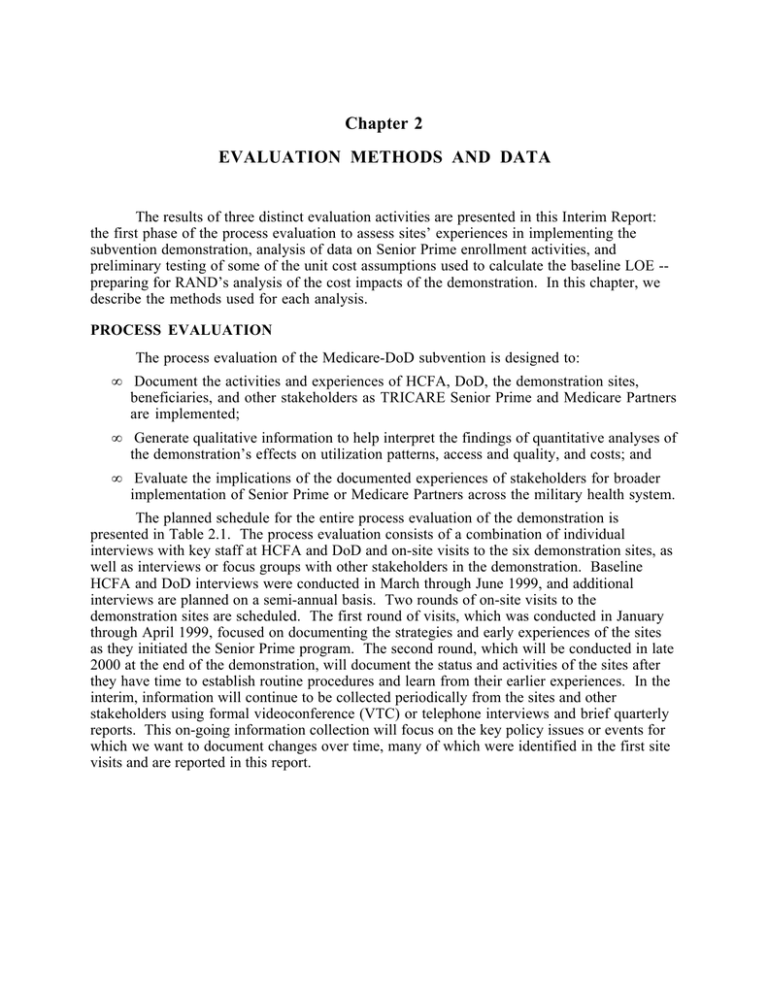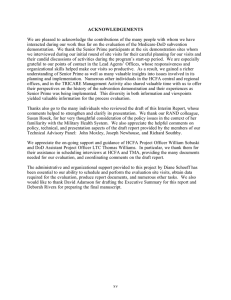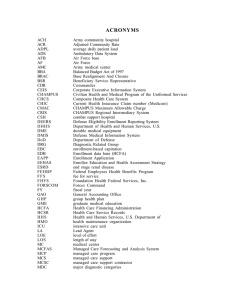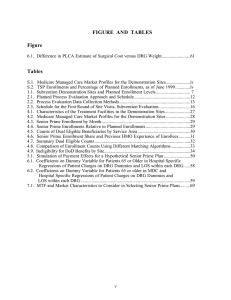Chapter 2 EVALUATION METHODS AND DATA
advertisement

Chapter 2 EVALUATION METHODS AND DATA The results of three distinct evaluation activities are presented in this Interim Report: the first phase of the process evaluation to assess sites’ experiences in implementing the subvention demonstration, analysis of data on Senior Prime enrollment activities, and preliminary testing of some of the unit cost assumptions used to calculate the baseline LOE -preparing for RAND’s analysis of the cost impacts of the demonstration. In this chapter, we describe the methods used for each analysis. PROCESS EVALUATION The process evaluation of the Medicare-DoD subvention is designed to: • Document the activities and experiences of HCFA, DoD, the demonstration sites, beneficiaries, and other stakeholders as TRICARE Senior Prime and Medicare Partners are implemented; • Generate qualitative information to help interpret the findings of quantitative analyses of the demonstration’s effects on utilization patterns, access and quality, and costs; and • Evaluate the implications of the documented experiences of stakeholders for broader implementation of Senior Prime or Medicare Partners across the military health system. The planned schedule for the entire process evaluation of the demonstration is presented in Table 2.1. The process evaluation consists of a combination of individual interviews with key staff at HCFA and DoD and on-site visits to the six demonstration sites, as well as interviews or focus groups with other stakeholders in the demonstration. Baseline HCFA and DoD interviews were conducted in March through June 1999, and additional interviews are planned on a semi-annual basis. Two rounds of on-site visits to the demonstration sites are scheduled. The first round of visits, which was conducted in January through April 1999, focused on documenting the strategies and early experiences of the sites as they initiated the Senior Prime program. The second round, which will be conducted in late 2000 at the end of the demonstration, will document the status and activities of the sites after they have time to establish routine procedures and learn from their earlier experiences. In the interim, information will continue to be collected periodically from the sites and other stakeholders using formal videoconference (VTC) or telephone interviews and brief quarterly reports. This on-going information collection will focus on the key policy issues or events for which we want to document changes over time, many of which were identified in the first site visits and are reported in this report. Table 2.1 Planned Process Evaluation Approach and Schedule Methods Schedule Individual interviews with HCFA, DoD staff Baseline, semi-annual Site visit interviews with: • lead agents • MTF command staff • MCS contractor personnel • physician managers • clinical and business managers • military retiree organizations Focus groups with “front line” staff, physicians Medicare health plan leaders Focus groups with dual eligibles at all sites First site visit at startup (January-April 1999) Mid-demonstration update on site strategies using telephone interviews with site leaders, DoD, HCFA, LAs End of 1999 Beneficiary feedback documented in MTF records for enrollments, complaints, grievances, others to be explored with sites Quarterly Site progress reports by telephone-check list of questions Quarterly Document MTF organization and operation from sites’ written materials As needed First year; last year Dual eligibles-2 nd visit (Sept-December 2000) We present here our data collection methods for the first round of interviews and site visits, including the types of baseline information we sought and the interview or focus group techniques used to collect that information. Then we describe the interviews conducted with HCFA and DoD staff and the structure and processes used for the site visits. Data Collection Methods The methods used to collect data for the demonstration activities of interest to the evaluation are listed in Table 2.2. Standard formats and procedures were used for data collection to ensure consistency across interviewers, sites, and time periods. To enhance our ability to capture the diversity of perspectives on implementation issues, we addressed many of the questions with several different stakeholders. Table 2.2 Process Evaluation Data Collection Methods Overall strategies Initial views on demo Execution of MOA Flow of funds Organization of system Meet HCFA requirements Training and education Provider networks Enrollment and marketing Quality assurance Actions and experience Effects on stakeholders: HCFA and DoD Lead agents MTF management Physicians Clinical and other staff Dual eligibles Other beneficiaries TRICARE contractors Medicare plans, providers Personal Interviews Group Discussions X X X X X X X X X X X X X X X X X X X X X X X X X X X X X X X X Provider Focus Groups Retiree Assn. Leaders X X X X X X X X X X X X X X Individual and Group Interviews. We prepared a semi-structured interview guide containing the questions to be addressed for the topics in Table 2.2. This master list of questions is presented in Appendix A. Based on use of the question list for our first site visit, we made some minor revisions and additions to the questions, and the revised format was used as the basis for the remaining five site visits and HCFA and DoD interviews. Working from the master list, we developed several interview guides that were tailored toward topics or issues relevant to specific stakeholders. For example, we prepared separate interview guides for HCFA Central Office staff, TMA staff, and HCFA Regional Office staff. Although we used the question list and interview guides to ensure we obtained all the desired information, we found that each interview had its own unique orientation, and we allowed flexibility for the order in which topics were addressed. The group interviews, in particular, tended to move in unpredictable directions as the group members engaged in discussion and interactions that often yielded rich insights into the dynamics underlying particular topics. Guided by the circumstances of each interview, we probed specific issues in greater depth to help guide our interpretation of the information obtained. Provider Focus Groups. We used the focus group format to gather information on the perspectives of three key provider groups within each site: the primary care managers (PCMs) who are physicians who manage clinical care for Senior Prime enrollees, the other “front line” clinical and support staff involved in clinical care delivery, and sub-specialty physicians who treat enrollees referred to them by the PCMs. The use of the focus group format enriched the information we collected on provider experiences in serving the dual eligibles by (1) involving a greater number of individuals than would be feasible to interview individually and (2) encouraging exchange of ideas and perspective among the group participants. Written protocols were used to establish the format for discussion, guide each focus group’s discussion, and ensure that all topics of interest are covered. A separate protocol was developed for each of the three provider groups. Depending on the site, 5 to 15 individuals participated in the focus groups. Typically, we started the focus group by asking each participant in turn to express some thoughts on his or her experiences with Senior Prime. Then we continued with specific questions covering the topic areas included in the written protocol.1 Individuals with management responsibility were not participants in the focus groups, although some clinical managers observed the sessions at many sites. With few exceptions, the discussion was candid and thoughtful, and participants shared their experiences and those reported to them by patients. Focus Groups with Retiree Association Representatives. In designing the process evaluation, we decided to conduct focus groups with dual eligible beneficiaries only during the second round of site visits at the end of 2000, to learn about the perspectives of dual-eligible beneficiaries after having experience with Senior Prime plans. To obtain information on the early viewpoints of the dual eligibles, we are relying on a combination of information sources, including focus groups with military retiree association representatives and the provider focus groups. We conducted focus groups with retiree association representatives at all but one of the sites, following the same basic format used for the provider focus groups. We also elicited information from the sites’ management teams about what they heard from beneficiaries as they worked with them during Senior Prime start-up, enrollment, and service delivery. The DoD Annual Beneficiary Survey, the GAO survey of dual eligible beneficiaries, and GAO focus groups with beneficiaries, which currently are being conducted, also will provide information on the baseline experiences and attitudes of dual eligibles about Senior Prime. Interviews with HCFA and DoD Participants Along with the site visits discussed below, the interviews of staff at the HCFA central and regional offices and staff in the DoD Office of Health Affairs and TRICARE Management Activity provide important “triangulation” of the multiple perspectives regarding the subvention demonstration. The demonstration was conceived at the top levels of government several years ago, and it was important for us to learn its history so we could understand the origins of the policy issues being argued and monitored today. In addition, we wanted to have a good “grasp” on the fullness of the specific activities and issues involved in implementing the demonstration, which could be obtained only by hearing about it from multiple perspectives. Interviews were conducted with a total of 15 staff in the HCFA central and regional offices. We conducted individual interviews with Policy Office staff, who negotiated the terms 1 The focus group format used for the Region 6 site differed substantially from this standard approach because the focus groups were conducted by videoconference with participants from all four MTFs. Because each group only had 15 minutes to share its views and concerns, we asked them to focus on selected topics. of the demonstration, and with staff in the Office of Managed Care, who handle the operational aspects of certification and compliance for Medicare health plans, including the Senior Prime plans. Individual interviews and a group interview also were held with staff in the Demonstrations Office who oversee the demonstration itself. Participants in the group interview were several individuals who currently are or had been project officers for the subvention demonstration (and the VA subvention demonstration), with whom we tracked the history of subvention negotiations from inception through its inclusion in the BBA and early implementation. Finally, individual interviews (five by telephone and one in person) were conducted with staff in six HCFA regional offices, each of which is responsible for one of the demonstration sites, to learn their roles and perspectives on Senior Prime. We interviewed 10 staff persons at Health Affairs and TMA, all of which were individual interviews except for a few that included two or three persons. Several of the interviews were with leaders or technical staff who had participated in the formulation of subvention policy and design for legislation and the MOA, including the Health Affairs staff person who led the DoD negotiations. These interviews offered information and insights into the DoD perspective on the history of the demonstration and related issues. Additional interviews were held with TMA staff who are currently involved in the policy, operation, or oversight of the demonstration. These include the staff who provide policy and technical support to the demonstration sites on a daily basis, as well as staff in the marketing department where the Senior Prime marketing materials were prepared. Structure of the Site Visits The first round of site visits was performed as specified in Table 2.3. Preparation for these site visits began with a meeting with representatives of the Surgeons General for the Army, Air Force, and Navy, at which we described our plans and study design for the process evaluation. These individuals gave us contact information for the TRICARE Senior Prime points of contact (POC) in the LA Offices for the six sites, with whom we worked to schedule the site visits and organize the interview agendas. We prepared a template for a site visit agenda that we provided to each site POC (see Appendix B). Working with the template, the POC tailored the agenda to the site’s unique situation and made all scheduling arrangements with the site’s participants. We provided a copy of the master interview guide to the site POC before the site visit a strategy that allowed the sites to prepare for the topics of interest to us and enabled us to cover a great deal of information efficiently. Throughout each site visit, representatives from the LA Office, participating MTF(s), and MCS contractors were active participants in the interviews. We also conducted a group interview with just the MCS contractor staff to capture the full scope of their roles and issues. During each site visit, we obtained written materials that describe the site and its Senior Prime program. Table 2.3 Schedule for the First Round of Site Visits, Subvention Evaluation Site Colorado Springs site: Evans ACH, Ft. Carson Air Force Academy Dover Air Force Base Keesler Air Force Base Madigan Army Medical Center Southwest Region site: Brooke Army MC, Wilford Hall MC Reynold ACH, Ft. Sill, Sheppard AFB Followup informal visit to Ft. Sill and Sheppard AFB to see the facilities San Diego Naval Medical Center Date of Visit 19-21 April 1999 12-14 April 1999 27-29 April 1999 23-25 February 1999 22-25 April 1999 5 and 7 May 1999 20-22 January 1999 In our introductory meeting for each site visit, we indicated our desire that the site visits be a shared-learning process for RAND and the sites, and not to “grade” them on their performance. Our goal was to provide actionable information to HCFA and DoD that can help them strengthen the Senior Prime program in the future, should a decision be made to make it permanent. Following each site visit, we prepared a written report that summarizes the information obtained from the team interviews and focus group discussion and presents the key lessons and issues identified from the site visit. The six site visit reports are presented in Appendix C. Issues that have been identified will be monitored on a quarterly basis through telephone interviews and teleconference communication with the points of contact at the sites. ENROLLMENT DEMAND We obtained enrollment data from both DoD and HCFA sources, which we matched with each other and reconciled to ensure that the set of dual eligibles established is as complete as possible. The sources of Medicare enrollment data are the Enrollment Database (EDB) and Group Health Plan (GHP) files. The EDB file provides master enrollment records for all Medicare beneficiaries including information on entitlement, enrollment, and Medicare status. The GHP file provides specific characteristics of beneficiaries enrolled in Medicare managed care plans, including the Tricare Senior Prime plans. DoD enrollment data come from the Defense Eligibility Enrollment Reporting System (DEERS), which records basic information on each eligible beneficiary, including residence information and other demographic data. These data were obtained from Vector Research, Inc. (VRI) and include the years 1992 through 1998 for DoD retirees and their dependents that are age 65 or older as of September 30 of each year. Quarterly DoD enrollment data will be collected from VRI for the duration of the evaluation. We created a population file from these data sources consisting of all Medicare-eligible DoD beneficiaries, including those dual eligibles currently enrolled in Senior Prime. Creating a dual-eligible population file that was as complete as possible required advanced database merging and sophisticated algorithm programming techniques2. Specifically, merging HCFA and DoD data sources required that enrollment data for all dual eligibles in the DEERS data be matched to the Medicare EDB. These two data sources use different systems for beneficiary identification, and therefore matching was done using common fields (i.e., Social Security Number [SSN], date of birth, and sex). A master file containing a unique Medicare Current Health Insurance Claim number (CHIC), Sponsor SSN, date of birth and sex was created and used to assign a common person identifier to all data source records. This file was then screened for duplicate records to establish a more accurate count of eligibles. Details of our findings on enrollment data consistency for this population are presented in Chapter 4. PRELIMINARY COST STUDIES In order to estimate the costs associated with dual eligible hospitalizations, the military apportions the cost of its inpatient MTF operations among each hospital case using a series of allocation rules. The cost studies reported here aim at estimating the accuracy of these cost estimates by examining the assumptions implicit in these rules. In particular, we examine whether elderly patients cost the same as non-elderly patients in the same DRG, and the rules used to apportion surgical costs and non-surgical ancillary costs. We do this by examining resources used by non-military patients. Data Sources California Discharge Abstracts. Hospital discharge abstracts from California were used to compare the resources used by patients 65 or older versus younger patients in the same DRG in the same hospital. California Office of Statewide Health Planning and Development (OSHPD) requires hospitals to provide a discharge abstract for each discharge during the calendar year. The discharge abstracts contain information on patient age, sex, diagnoses, procedures, disposition, expected payment source, length of stay, total charges, and DRG. DRG assignment is performed by OSHPD, and is based on the HCFA Grouper in use at the beginning of the calendar year. We used a set of 2,039,229 discharges during calendar year 1996 from 373 California acute care hospitals. We excluded children’s hospitals, psychiatric hospitals, rehabilitation hospitals, a small number of hospitals known to provide incomplete charge data3, and 11 acute care hospitals with fewer than 50 elderly discharges or fewer than 50 under-65 discharges. Our data consists of all discharges from each included hospital except for those related to childbirth—i.e., discharges in Major Diagnostic Categories (MDC) 14 and 15. Medicare Discharge Abstracts. Medicare discharge abstracts were used to study the method for allocation of surgical costs and ancillary costs among inpatients. Medicare discharge abstracts were taken from the calendar year 1996 Medicare Provider Analysis Review (MEDPAR) file, which contains all Medicare hospital discharges during the federal fiscal year. Medicare Cost Reports. We used the Medicare cost reports to estimate costs for our MEDPAR sample. We used the PPS XII cost report file which contains data on hospital cost 2 A technical summary of these programming procedures are available upon request from Fu Associates. 3 The exclusions consist of hospitals listed as ‘all inclusive providers’ on their Medicare cost reports and Kaiser foundation hospitals which do not use charges for billing purposes. report periods ending between Sept 30, 1995 and Sept. 29 1996. These reports provide estimates of the total cost of, and charges for, services delivered in each ancillary department and the per diem costs in routine care and special care units. We selected only short-term acute care hospitals participating in the Prospective Payment System and excluded those with bad data. In particular, we deleted “All Inclusive Providers”, hospitals that did not file a full cost report, and those hospitals that reported intensive care days on the MEDPAR, but did not separately report the costs associated with that care on their cost report. Our file available for analysis thus contains 4,145 hospitals with a total of 9,850,237 hospital discharges. In the work reported here, we analyze only surgical cases which reduces the file to 3,927 hospitals with surgical cases and 2,947,244 surgical discharges. Measuring cost For the comparison of costs between the elderly and non-elderly, we use charges as our surrogate for costs. In this analysis, we control for DRG and length of stay within the hospital. Patients in the same DRG in the same hospital with the same LOS, should be using a similar mix of wards and should require services from similar ancillary departments. Consequently, we believe that the charges for patients in the same DRG and with the same LOS should be proportional to cost. For the analysis of surgical costs, we use the departmental accounting method.4 The cost report data were used to generate ratios of cost to charge for each of 12 ancillary departments and to estimate the per diem cost of routine care and the per diem cost of care in intensive care unit and in a coronary care unit. To estimate ancillary costs for the case, ancillary charges for the case are first aggregated into the 12 departments for which ratios of cost to charges are calculated. The charges in each department are then multiplied by the cost to charge ratios and then summed across departments. This method has been compared to the, presumably better, relative value method and found to be a reasonable way of estimating average costs at the DRG level with-in hospitals.5 In particular, for 70 percent of DRGs, estimated cost was within 10 percent of that calculated with RVUs. 4 Newhouse, Joseph P., Shan Cretin, and Christina J. Witsberger, “Predicting Hospital Accounting Costs,” Health Care Financing Review, Vol. 11, No. 1, Fall 1989, pp. 25–33. 5 Swartz, Michael, DW Young, R Siegrist, "The Ratio of Costs to Charges: How good a basis for estimating costs?", Inquiry, Winter 1995-96



